

THE MAASAI
When the rainy season paints its greenery across the East African landscape, the grasses of the Serengeti are transformed into billowy waves of an emerald sea. A flash of red is easily discerned in the distance as a shuka-clad (a short red robe worn like a toga) morani (Maasai warrior) strides swiftly and purposefully across the unending plain. He comes from out of nowhere and no one knows where he is going. It is a scene, often repeated throughout Maasailand, that is symbolic of the Maasai as a people. No one is quite sure where they have come from or how they will preserve their culture in the future.
Origin
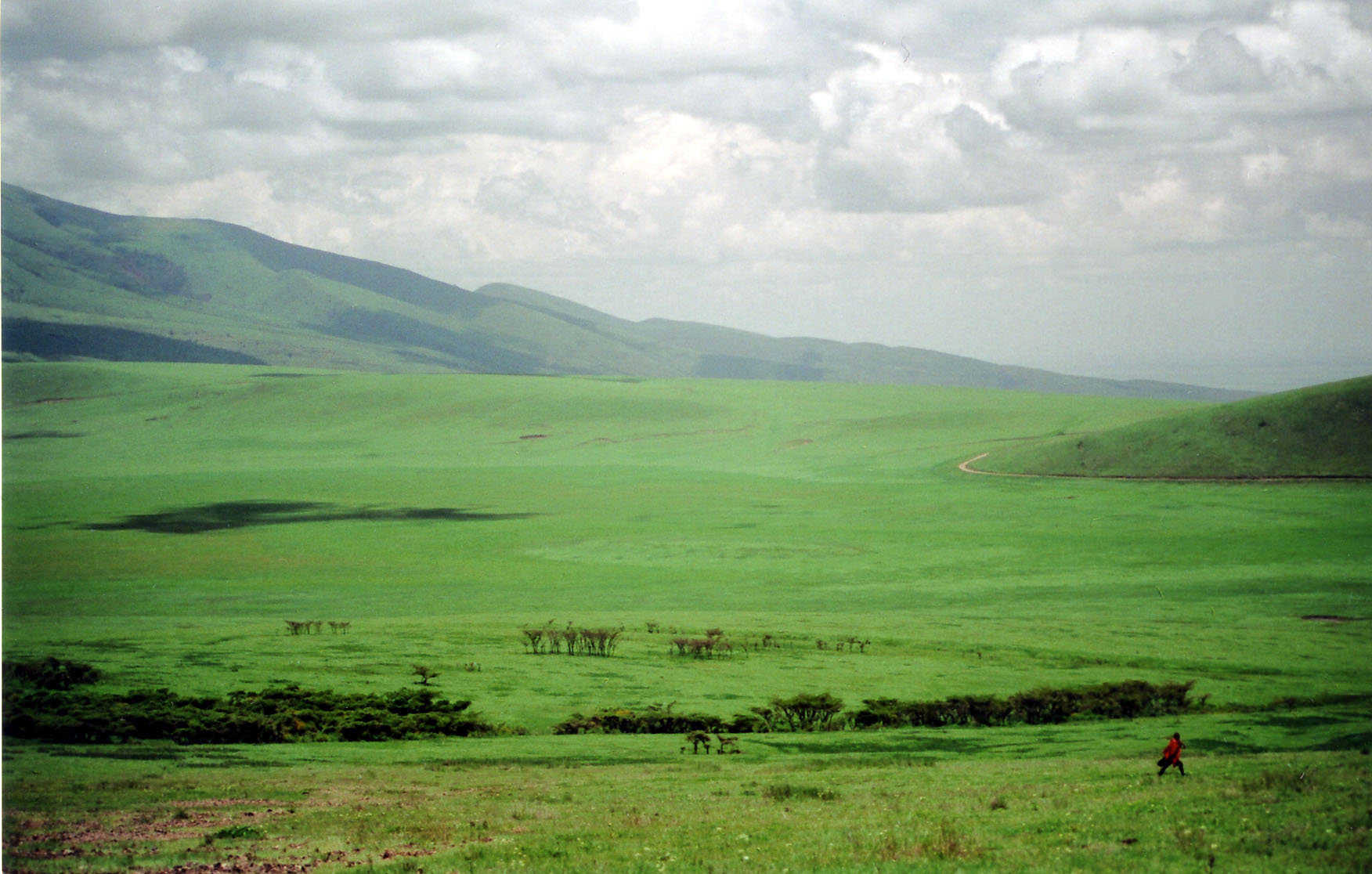 |
A Flash of Red Across The Unending Plain |
Importance of Cattle
The designation of 'Maasai' (speakers of Maa) is generally reserved for the warrior-class, semi-nomadic pastoralists although Maa is also spoken by various agricultural tribes. Like other cattle herders of East Africa, the Maasai asserted a higher social status than those that tilled the soil or worked with their hands. Pastoralism, which furnished food, drink, clothing, housing, bedding and ornaments provided a more secure existence than agriculture and was a means of storing wealth. However, the herds were vulnerable to any upset to the fragile ecology of the savannas and additional security was established by alliances and relationships that allowed for the replenishment of cattle in times of need. Thus, non-pastoralist tribes with few, if any, cattle, were regarded as ndorobo (poor people), lacking not only material wealth but essential contacts with the wider society.
Misunderstanding their value system, an American traveler, Mary French-Sheldon wrote in 1892: 'They will not work, they have not the pride of the Wa-Chaga in forging their own spears, but depend upon the vulcans of Chaga for their fine weapons and metal work.'
Later, Sir Charles Eliot, the first Commissioner for British East Africa, described the Maasai as 'magnificent layabouts; superb to behold' but 'of no economic consequence whatsoever.'
Social and Economic Structure
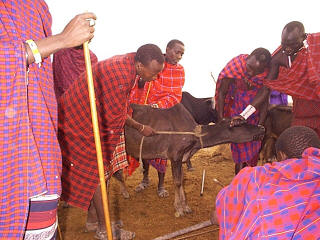 |
Bleeding a Cow Photo by Glenn Brock |
Ceremonial group circumcision initiates age-related boys into manhood. It begins their tenure as warriors, a period of approximately 8 to 12 years, during which they progress from junior to senior warriors. The primary responsibilities of warriors are to protect the community from predators and other tribes and to raid cattle to increase their herds. Modern laws and regulations have diminished their function. Cattle raids are now illegal and their lands are greatly diminished. However, in pre-colonial times, every community knew the extent of their territory even though there were no legal titles or fences. Sustainable cattle herding required vast expanses of land and the role of the moran in maintaining the integrity of a tribe's borders was essential. In addition, warriors supervise grazing, continually assess the condition of the pastures and seek out new pasturage when indicated.
The E Unoto or 'coming of age' ceremony marks the transition from warriorhood to elderhood and is the most important event in the lives of Maasai men. As junior elders, they are allowed to acquire cattle and to marry. Maasai men are polygamous and take as many wives as they can afford. This secures the family in an uncertain environment. More wives extend the network of friends and relatives and increase the number of children. More sons enable families to split up their animals, thereby reducing the probability of losing an entire herd to disease or misfortune. Having already proved their physical courage and abilities as warriors, junior elders now embark on sharpening their mental prowess. Intelligence and wisdom are prized qualities because elders are responsible for the overall welfare of Maasai society. They uphold their traditional laws and spiritual mores and they impart their specialized knowledge to young people. This includes but is not limited to the use of herbs for animal and human health, observing the sky to determine the timing of events and to predict rain, planning cattle itineraries based on the warriors' ecological reports of the pastures, and active range management to induce optimal grazing conditions. After advancing in age and fulfilling their duties to the tribe, the responsibilities of elders are relaxed as they take on the role of senior elders. Senior elders are highly respected and sought out for their knowledge and experience.
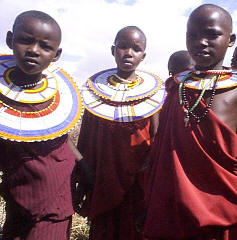 |
Maasai Girls Photo by Glenn Brock |
Maasai women are primarily involved with the day to day running of their households. They collect water and firewood, prepare meals and raise their children. Whereas men are responsible for maintaining the herds and the ritual slaughter of the animals, women collect and utilize the by-products. They milk the cows, clean and prepare the hides and build their houses with dung and mud. Young girls assist their mothers in preparation for their role as wives and mothers. Like the boys, they are initiated into adulthood by means of circumcision at around 13 to 15, after which they are eligible for marriage. Maasai women, like traditional women everywhere, find fulfillment in marriage and their children.
European Arrival
During the past two thousand years, boats from Arabia, India, Persia, China and Indonesia sailed up and down the East African or Zanj coast, as it was known, in search of gold, ivory, ambergris, slaves and spices. Around the 8th century AD, Arabian and Persian traders began to settle along the coast and by the 15th century, the main trading centers formed a string of independent city states that Vasco da Gama encountered on his way to India in 1498. The Portuguese took advantage of the rivalries between the trading centers to gain control of the coast in 1525 but were ousted as their power waned less than 200 years later.
The takeover by Omani Arabs coincided with a great increase in demand for slaves to work on plantations in Zanzibar and other islands off the coast of Africa. Zanzibar became a major slave trading center as Arab and Swahili traders scoured the interior of present day Tanzania for ivory and slaves. The sultan's caravan routes to the lake region passed through heavily infested tsetse fly areas that made it impractical to use mule or oxen transport so slaves were required to carry the ivory to the coast where they were then sold for plantation labor. Maasai tribes, who already occupied northern Tanzania, forced the slave traders to skirt Maasai territory to reach Lake Victoria. The Maasai never submitted to slavery. They would fight to death and if taken inadvertently, would usually die inexplicably in captivity.
The founding of the African Association in London in 1788 heralded the beginning of European interest in the scientific exploration of Africa. However, this interest was firmly rooted in economics as one founding member wrote: "Gold is there so plentiful as to adorn even slaves…If we could get our manufacturers into that country we should soon have gold enough." Concurrently, anti-slavery sentiment was sweeping Europe resulting in renewed missionary zeal. It was, therefore, the missionaries and explorers, who initially documented their impressions of the Maasai. Among the first were German missionary, Ludwig Krapf (1848), English missionary, Charles New and later, explorer and naturalist, Joseph Thompson (1883).
In the mad 'Scramble for Africa' that ensued, the Anglo-German Agreement that dissevered Maasai territory into British and German Spheres of Influence in November, 1886 was an ominous precursor to events predicted earlier by Mbatiany, the Oloiboni (spiritual leader) and most influential Maasai at that time. He foretold the coming of Europeans on an 'iron rhino with strangers of flamingo pink on its back' as well as the cycle of disaster known as Ol Maitai. Mbatiany did not live to see the drought and famine that left the Maasai and their herds weakened and susceptible to smallpox and rinderpest, European diseases that caused the loss of about 50% of their people and 80% of their cattle. Nor did Mbatiany anticipate the years of intertribal conflict that resulted when he was tricked into giving his deathbed blessings to his son, Olonana (known to the British as Lenana) rather than to his chosen heir, Senteu.
The Twentieth Century
The Maasai were a destitute, demoralized and divided people when the first colonists arrived at the end of the 19th century. They were ill-prepared for the British who coveted their best pastures in the highland areas of the Rift Valley in present day Kenya where the soil was fertile, water sources were reliable and the cooler temperatures were more attractive. Sir Charles Eliot wrote in 1903, ' I cannot admit that wandering tribes have a right to keep other and superior races out of large tracts merely because they have acquired the habit of straggling over far more land than they can utilize.' Vast areas of their land were lost and they found themselves either herded into southern reserves near the Tanzania border or as squatters on their own land. The Maasai in Tanzania fared better from the initial onslaught of colonialism because there were not as many German settlers and except for small areas around Kilimanjaro, their land was not as fertile or as hospitable to Europeans. Even after WWI when German East Africa passed to the British and renamed Tanganyika, there were few British willing to settle there.
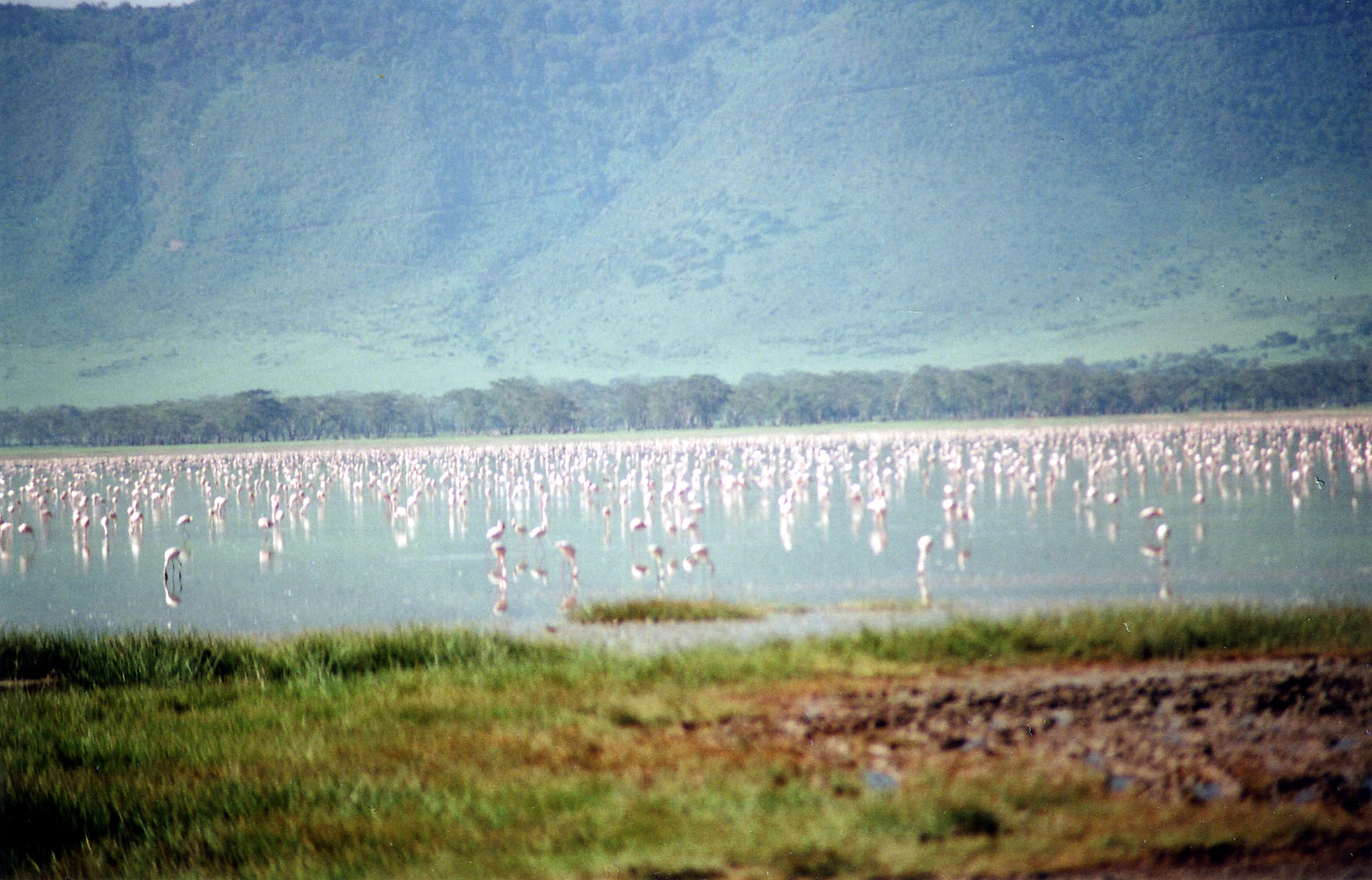 |
Flamingos at Ngorongoro Crater |
Today, the Maasai have lost fully two thirds of their original lands. Unable to move their herds in traditional ways, overgrazing led to the degradation of much of their remaining land and impoverishment of the majority of the people. Some moved to the towns to find work while others turned to agriculture and even poaching. After enduring more than a hundred years of displacement and poverty, it is ironic that some experts now conclude that pastoralism, which necessitates the preservation of the environment, is the most productive system for the savannas of East Africa and the indigenous knowledge of the Maasai is gaining credibility.
The cycle of Maasai herd movements and range management depends upon the rains. At the end of the dry season, the Maasai would burn off the parched vegetation. This served to rid the area of disease-carrying ticks, to control the growth of less desirable grasses and to improve the soil with nutrient-rich ash. Tender young shoots of the grasses favored by cattle and wildlife emerged with the first rains. Burning was thought to be 'destructive' and banned. As a result, the coarser grasses took over and the quality of the pastures declined. After the rains, the Maasai moved their herds to the more arid areas that were aburst with fresh growth, giving the richer pastures time to recover until the dry season set in. However, when much of the better pastures that could sustain the herds during the long, dry season, were taken for agriculture and parklands, the Maasai had no recourse except to allow the cattle to overgraze the areas to which they were confined.
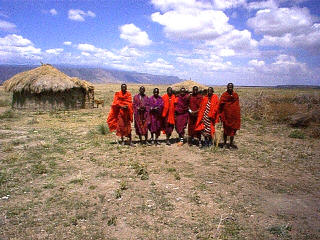 |
Maasai Boma Photo by Glenn Brock |
The underlying purpose of banning pastoralists from the parks is more subtle and is found in the words of Dr. Bernhard Grzimek, a German conservationist who initiated worldwide interest in the Ikoma-Itutwa National Park when he made the film, Serengeti Shall Not Die, in 1958. He said: 'A National Park must remain a primordial wilderness to be effective. No men, not even native ones, should live inside its borders.' Thirty years later, Anthony Smith, in his book, The Great Rift: Africa's Changing Valley, that accompanied a major BBC television series, wrote of two German families that lived within the Ngorongoro Crater in 1908: 'It is easy to be appalled that the men should have attempted to farm in such a perfect animal preserve… How did they manage to grow crops with such a profusion of herbivores? How could they maintain any animals (1200 head of cattle) when surrounded by so many carnivores…?' The savanna ecology has always been a fragile balancing of man, wildlife and plants and as we strive to create and maintain areas of 'primordial wilderness,' we have disregarded man's role in the natural equilibrium of the savanna.
The Future
It is of little consolation to the Maasai, that nomadic pastoralism is now acknowledged to support more people on the savannas than agriculture. Agricultural interests have already intruded on the savannas leaving behind degraded land within three years of initial cultivation. Nor is there comfort in knowing that the great herds of East Africa flourished best under Maasai stewardship. The pressure of burgeoning populations in East Africa now requires that the reserves and parks remain as islands of endemism if the flora and fauna of are to survive. The reality, at the dawn of the twenty first century, is that pastoralism may no longer be an option for the Maasai.
Still, there is optimism that the Maasai culture will survive. They have a long history of adapting to changing conditions. Their traditions are steeped in the art of survival. They have endured a century of Westernization to emerge as one of the most culturally intact of the African tribes. They know that life itself, is subject to the rhythms and cycles of nature. Perhaps, with time and new tools, they will be able to restore the vitality of the Maasai as a people and contribute to the healing of the East African savannas.
Best Times To Go: Tanzania's animal life and climate is conducive to year round tourism. February to March is a particularly beautiful time between the short and the long rains when the land is alive with new growth.
Getting There: Most visits to Tanzania's Maasailand will originate in Arusha. From Europe, KLM flies directly to Arusha's Kilimanjaro International Airport. Overland, buses are available from Nairobi, Mombasa via Tanga and Dar-es-Salaam.
Clothing/Gear: Days are warm and nights are cool, especially on the rim of the Ngorongoro Crater with an altitude of about 7500ft. Be sure to take a camera with spare batteries and lots of film, binoculars, flashlight, a wide brimmed hat with a drawstring, good walking shoes, insect repellent, suntan lotion and personal toiletries.
General Information: Maasai cultural encounters are relatively new and not as developed in Tanzania as they have been in Kenya. To date, the Maasai in Tanzania have benefited very little from tourism. Visits to Maasai villages and walks through Maasai lands are now offered by most tour operators in Arusha. Some operators also offer homestay opportunities as well as the possibility of observing cultural activities. Currently, the Maasai are pursuing projects that will benefit their people more directly. Maasai author, Tepilit Ole Saitoti, is in the process of organizing a tour company. Stanley Saruni, project manager for American Liberty Oil Company (T) Ltd., is developing the E Unoto Retreat, a five star secluded lodge on Maasai land belonging to Mr. Saruni's tribe.
Planning Tips:
Important Resources:
E Unoto Retreat
PO Box 15234
Arusha, Tanzania
Phone: +255 (0)74-436-0908
Fax: +255-27-254-8542
Email: eunoto@massaivillage.com
The E Unoto Retreat is a five star lodge that nestles against the Great Rift Escarpment with a beautiful view of Lake Miwaleni. This unique establishment is designed to provide world class accommodations for its guests while benefiting the local Maasai. Visitors have the opportunity to associate directly with the Maasai and to observe and share many facets of their lives. Nature walks, storytelling and other educational programs are available to forge a better understanding of the Maasai and their role in preserving their environment.
The tranquil, natural splendor of the E Unoto Retreat is ideal for relaxation and rejuvenation. It's proximity to the Ngorongoro Crater, Tarangire National Park and Lake Manyara National Park allows easy day trips and a more leisurely safari. Those who prefer a more rigorous safari will enjoy the opportunity to 'recover' before returning home.
Related Books:

Adventures Great and Small © copyright 1996-2005